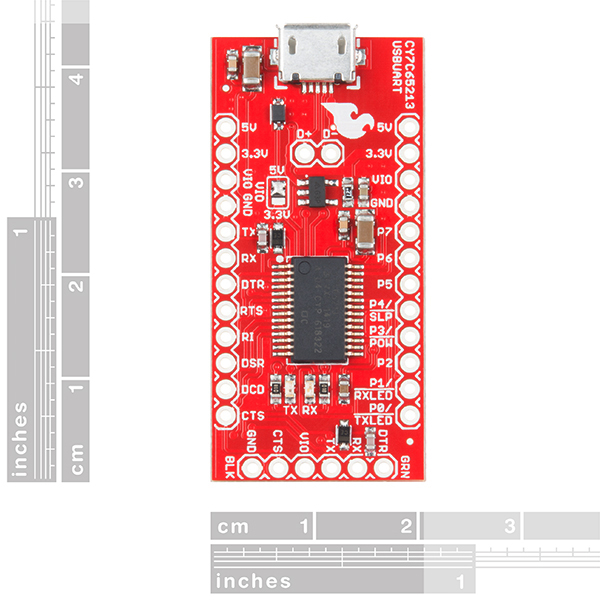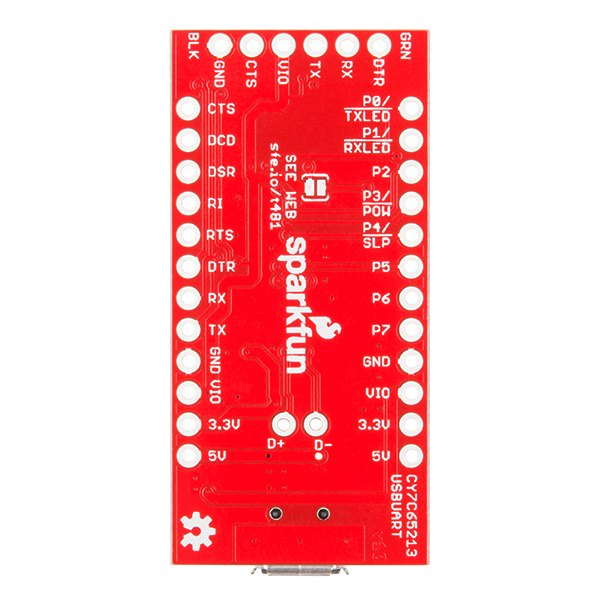SparkFun USB UART Serial Breakout - CY7C65213
The CY7C65213 USB to UART serial breakout is designed to provide users with a means to access all available I/O pins on the IC, and to provide a 6-pin UART header that is compatible with other SparkFun breakout boards. This breakout has a microUSB connector and other support circuitry to get the IC quickly up and running.
The CY7C65213 breakout is equipped with a micro-B USB port, USB signal lines, a VIO selection jumper, a low-voltage selection jumper, and a multitude of pins that allow you to utilize the board to its fullest potential. The CY7C65213 breakout is capable of operating at both 3V and 5V based on what the VIO selection jumper is set to. Additionally this breakout can operate at 2V and below.
- Schematic
- Eagle Files
- Hookup Guide
- Datasheet (CY7C65213)
- Cypress USB UART SDK
- GitHub
SparkFun USB UART Serial Breakout - CY7C65213 Product Help and Resources
SparkFun USB UART Breakout (CY7C65213) Hookup Guide
February 2, 2017
How to use SparkFun's advanced USB UART breakout, based on the Cypress CY7C65213.
Core Skill: Soldering
This skill defines how difficult the soldering is on a particular product. It might be a couple simple solder joints, or require special reflow tools.
Skill Level: Noob - Some basic soldering is required, but it is limited to a just a few pins, basic through-hole soldering, and couple (if any) polarized components. A basic soldering iron is all you should need.
See all skill levels
Core Skill: Programming
If a board needs code or communicates somehow, you're going to need to know how to program or interface with it. The programming skill is all about communication and code.
Skill Level: Rookie - You will need a better fundamental understand of what code is, and how it works. You will be using beginner-level software and development tools like Arduino. You will be dealing directly with code, but numerous examples and libraries are available. Sensors or shields will communicate with serial or TTL.
See all skill levels
Core Skill: Electrical Prototyping
If it requires power, you need to know how much, what all the pins do, and how to hook it up. You may need to reference datasheets, schematics, and know the ins and outs of electronics.
Skill Level: Rookie - You may be required to know a bit more about the component, such as orientation, or how to hook it up, in addition to power requirements. You will need to understand polarized components.
See all skill levels
Comments
Looking for answers to technical questions?
We welcome your comments and suggestions below. However, if you are looking for solutions to technical questions please see our Technical Assistance page.
Customer Reviews
4.7 out of 5
Based on 3 ratings:
Works great
Great interface to my network analyzer
Good product
Board is well labeled and works like a charm.
Works in applications wherein the FTDI and SiLabs parts won't
This part is well behaved with hardware handshaking at 115200 baud. When connected to devices with only a single rx register (e.g. STM32L4) and you need hardware flow control (as I did), you can't use FTDI part based product as they will send an extra byte after the flow control de-asserts (this info is buried in an FTDI app note and I confirmed it with their field app engineer) and this causes an overrun error. This Cypress part does not have this problem. Yay! As a further note - I've now also tested bridge dongles based on the Silicon Labs (aka SiLabs) CP2102 parts and they also did not work (for the same reason as the FTDI parts) in my application. (update on 19Feb21 - Note that native ubuntu drivers do not support hardware flow control on this device <argg> but there is apparently a "vendor mode" to get this to work... Win10 drivers work great with hardware flow control.)





Hi gang, I've put together a fork of python-ucdev which will let you access the CY7C65213 GPIO pins from python with simultaneous pyserial communication. There's also a guide showing how to get it up and running on Linux (Raspberry Pi). https://github.com/PaulZC/python-ucdev Enjoy, Paul
It seems rather obvious to me anyway that the solder jumper would be much more useful as a 3 position switch. Why risk lifting the pads or damaging the board with a soldering iron when you could have used a convenient switch in its place.
Unfortunately there is just not enough room on this board to put a switch on the PCB. You can however clear the jumper, and wire your own switch to the 5V, 3.3V and VIO pads beside it. That would allow you to easily change voltage from 5 volt to 3.3 volt with just the flick of a switch.
What are the benefits of this over the ftdi board - other than it not being from ftdi?
I notice the datasheet says the default baud rate is 115200. I think the FTDI stuff from sparkfun at least (e.g. DEV-09716) is stuck at 57600 (at least that's the rate the works for me with avrdude).
So hopefully you could get twice the upload speed when using non-rev3 Arduinos (e.g. sparkfun Arduino pro, pro mini, etc.). Sparkfun can you confirm this?
Together with the avrdude -V option to disable verification edit/compile/debug of large sketches becomes much less painful.
The data rate of uploading is actually set by the bootloader programmed into the chip, so the Pro/Pro Mini will always be limited to 57600, regardless of the serial bridge you use.
Sadly, it's unlikely that we'll change the Pro/Pro Mini bootloader anytime soon, as that would render the IDE incorrect and unable to upload.
Not being from FTDI is a sufficient selling point in some situations. The FTDI chips are popular for non-serial-port applications, some of which require (under Linux, anyway) unloading the ftdi_sio driver and thus rendering regular serial dongles inoperative for the duration. In such a case, having a couple of Brand-X serial dongles around, using a different driver, is very helpful.
Agreed, FTDI has a pretty bad name in the tech community these days. I recently was looking on Sparkfun for a non-FTDI option to evaluate for a project, but there wasn't anything, so this is good to see. I ended up using this: http://prolificusa.com/portfolio/pl2303sa-usb-serial-bridge-controller/ as an awesome little 8-pin chip just for RX/TX. @Sparkfun: the PL2303SA with a tiny breakout could be a nice minimal non-FTDI option, too, and it can also go all the way down to 1.8V.
To be specific about why they have a bad name, FTDI released windows drivers that deliberately bricked FTDI clones. In other words they deliberately destroyed the hardware of users that likely had no idea they were even using a clone. I've been eager to ditch them for good ever since I learned this.
The ability to operate all the way down to 1.8V? That's the most significant difference.
NOTE: If you are intending to connect to a single rx register device (like, my case, the STM32L4) and you need real hardware flow control at 115200 (like I did), this part (Cypruss CY7C65213) will work but NONE of the FTDI based parts will work (as they will send another byte after you de-assert the flow control line and cause an overflow. FTDI does refer to this problem in an app note but not in the data sheet).
IF you are competent reworking surface mount parts, it is straight forward to convert this board for use on 1.8V systems. The procedure is: 1) Remove the SOT23 3.3V regulator (says G3P on top) and replace it with a matched series 1.8v regulator (AP2112K-1.8TRG1, Digikey AP2112K-1.8TRG1DICT-ND, says G3M on top. 2) Move the voltage selection jumper from "5.0" to "3.3" (note: that position is now 1.8V). 3) Apply the jumper on the backside of the board selecting for voltages below 2.0V. 4) Use the configuration application (see other SparkFun app notes) to program the part for less the 2.0V IO voltages (this turns off an internal regulator on the Cypress part).
And you are good to go. Worked for me.
Link to the "Get started with the ... breakout guide" below the description is broken...
Sorry about that, we'll get it fixed asap. In the meantime, here's the proper link: https://learn.sparkfun.com/tutorials/sparkfun-usb-uart-breakout-cy7c65213-hookup-guide
if(oldLink != isWorking)
{
useNewLink;
bump();
}